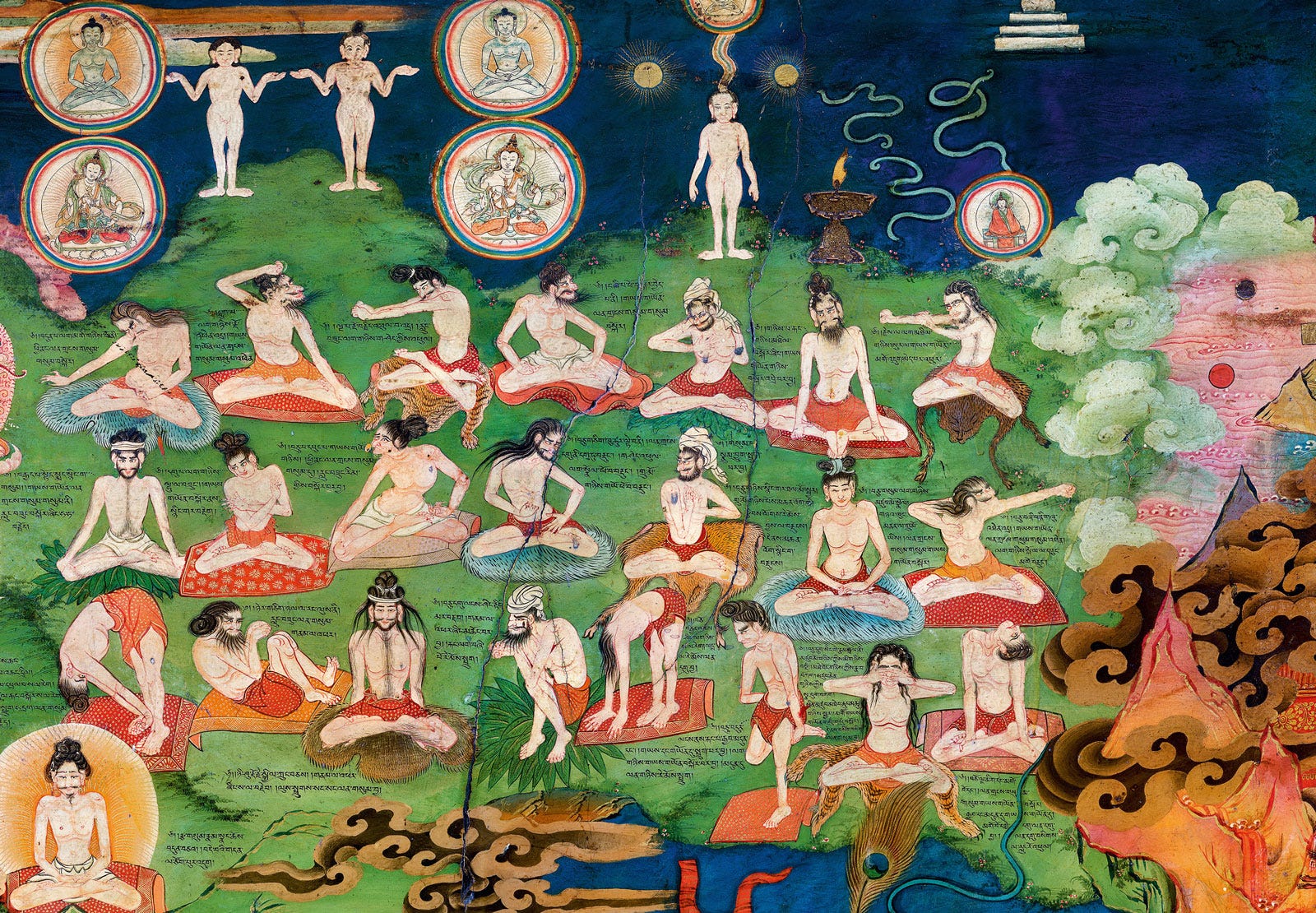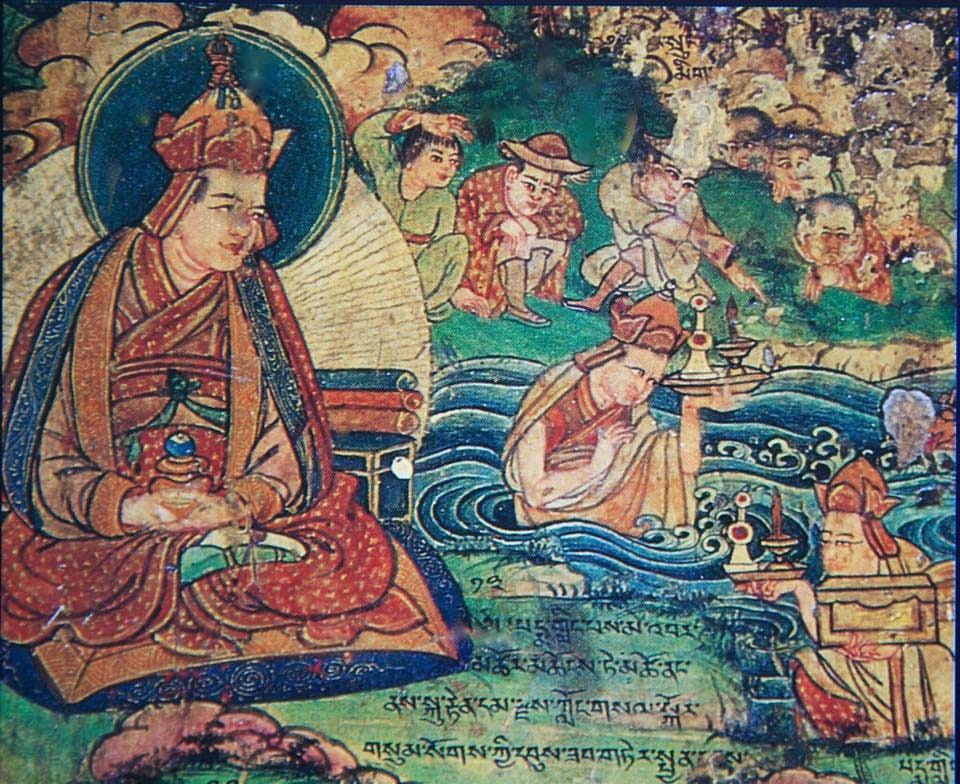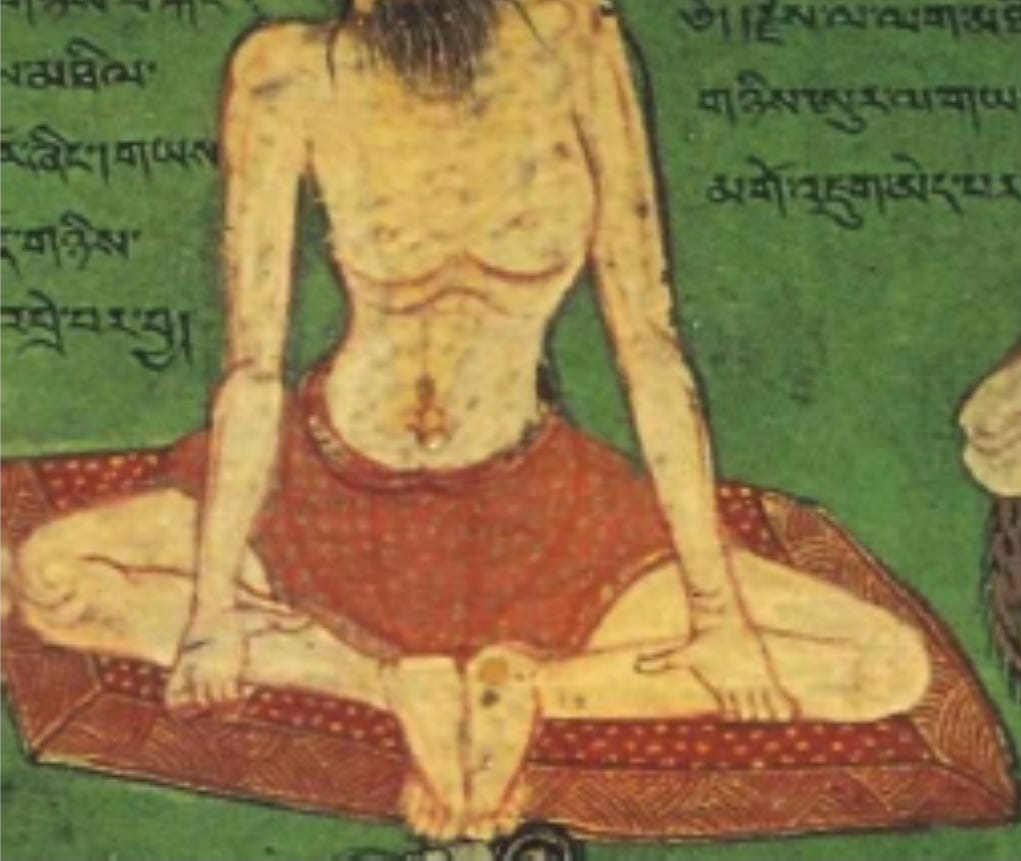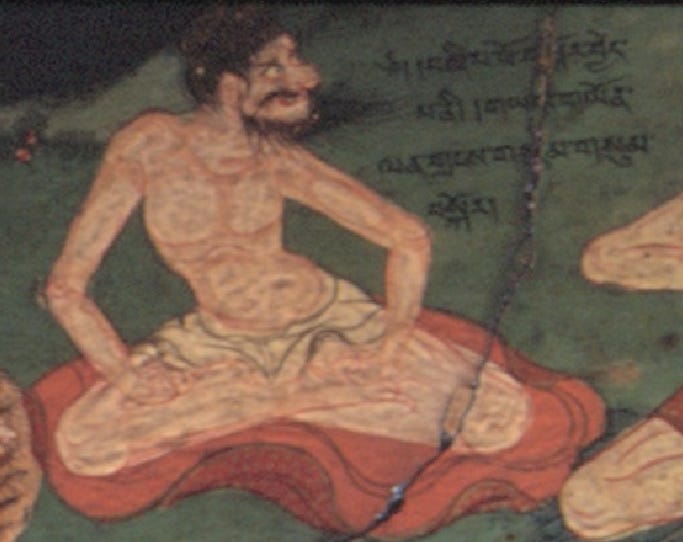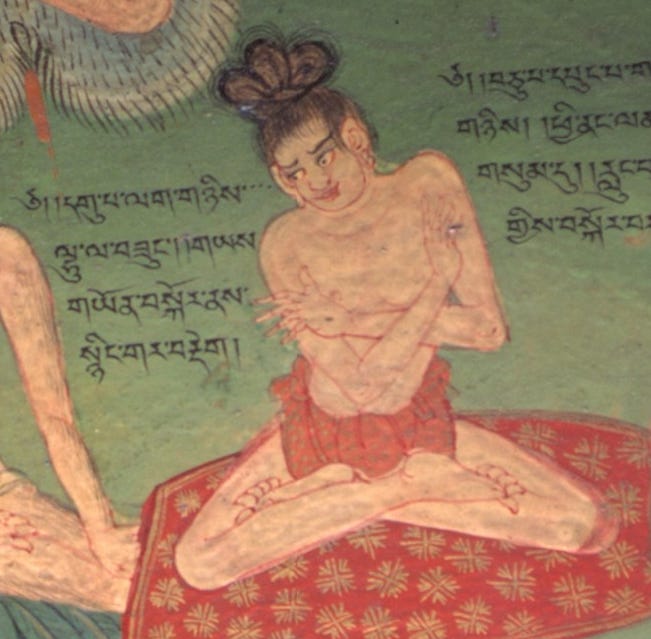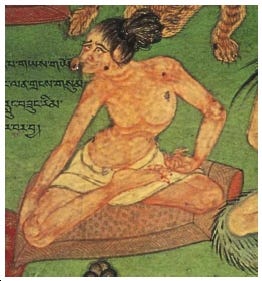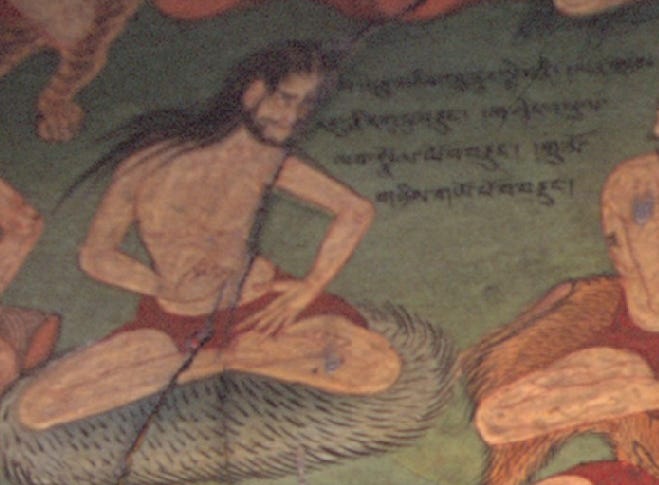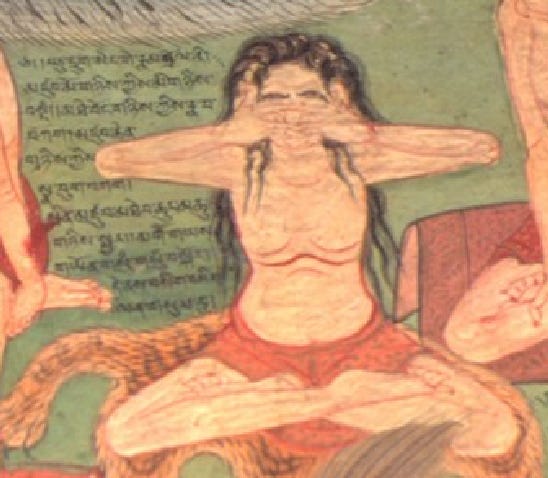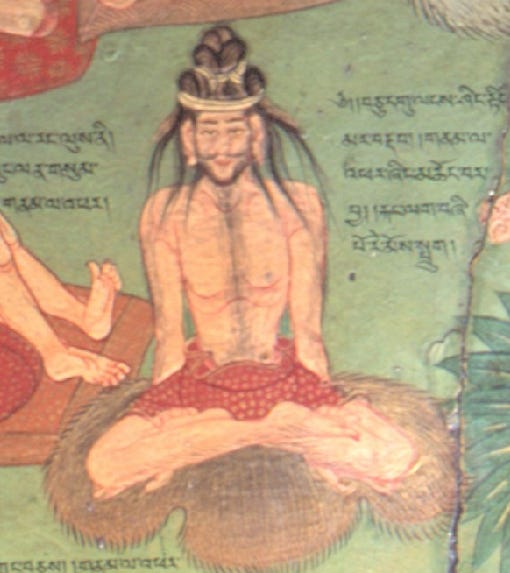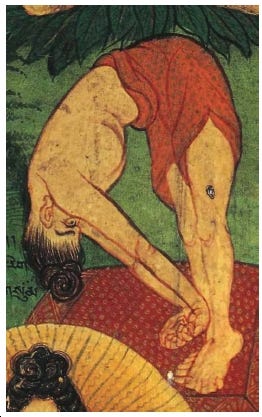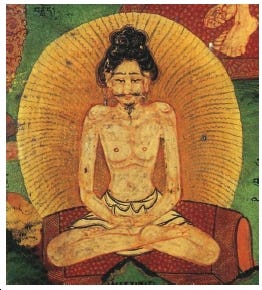The Twenty-Three Trülkhors of Pema Lingpa's Treasure Text: Illustrated in the Lukhang Temple Murals
Translator’s Notes
Scholars have identified the source text for the Dzogchen Lukhang murals—depicting yogis in various Trülkhor postures—as Orgyen Pema Lingpa’s treasure text "Secret Key to the Tsa Lung Trulkhor Practice," from the Compendium of Samantabhadra’s Intention cycle. For further reading, see Jakob Winkler’s The Dzogchen Murals of the Lukhang in Lhasa. An excellent translation of this particular text is also available in Dr. Ian Baker’s article, Embodying Enlightenment: Physical Culture in Dzogchen as Revealed in Tibet’s Lukhang Murals. Nevertheless, I have attempted my own translation of the text.
Please note: this translation should not be used as a practice manual. Inevitably, there may be inaccuracies, as it is impossible to fully understand the actual movements without firsthand experience—or guidance from someone who possesses it, which I do not. This translation is presented solely for educational and informational purposes.
I found three different copies of this text on BDRC, which mainly differ in spelling and occasionally in wording. The words in brackets in the translation are my interpretations. The Tibetan words in brackets within the Tibetan text reflect what I consider the correct form.
The twenty-second Trülkhor was particularly difficult to translate, especially when compared to the corresponding mural image, which depicts a standing posture. However, I have based this translation on a specific Trülkhor movement known as the “Flying Peacock.” In this practice, the yogi, seated in a half cross-legged posture while holding the big toes, rolls forward to touch the forehead to the ground, and then rolls backward, bringing the crossed legs upon the head.
Text and Translation
Title
ཀུན་བཟང་དགོངས་པ་ཀུན་འདུས་ལས་རྩ་རླུང་༼འཁྲུལ་འཁོར༽་གསང་བའི་ལྡེ་མིག༎
Secret Key to the Tsa Lung [Trülkhor Practice] from the Compendium of Samantabhadra’s Intention.
Homage
ཀུན་བཟང་དོན་གྱི་ལྷ་ལ་ཕྱག་འཚལ་ལོ༎
Homage to the ultimate deity, Samantabhadra — [the self-arising primordial wisdom].
The source and the Intention of the Teaching
བདག་འདྲ་པདྨ་ཐོད་ཕྲེང་ངས། ཟབ་ཆོས་དགོངས་པ་ཀུན་འདུས་ཀྱི། གདམས་པ་ཉམས་སུ་ལེན་པ་ལ། རྩ་རྣམས་འཁྲུགས་དང་འགྲིམ་[སྒྲིམ]པ་དང། རླུང་མཁྲིས་བད་ཀན་ལ་སོགས་དང། ལུས་ཀྱི་དར་གུད་སྙོམས་པའི་ཕྱིར། རླུང་ཁྲིད་གསང་བའི་ལྡེ་མིག་བསྟན༎
By putting into practice the teachings of the profound Dharma — Kunzang Gongpa Kundü — in order to harmonize the disturbed and twisted channels, [the three bodily humors] wind, bile, and phlegm, and the decline of the physical body, I, Padmasambhava, reveal the secret key instructions of vāyus [and nāḍīs].
Where to practise
དབེན་པ་མི་མེད་ཡངས་པ་རུ།་
[Practice it] in a spacious, open area where no people are present.
When to practise
ཐོད་རྒལ་དམིགས་མེད་བརྟེན་པའི་དུས།
At the time of practicing objectless (non-referential) Thögal.
Arousing Bodhicitta
རང་ཉིད་ཙོག་བུར་འདུག་བྱས་ལ། ཁམས་གསུམ་སེམས་ཅན་ཐམས་ཅད་དོན། བྱམས་དང་སྙིང་རྗེ་ཚད་མེད་བསྒོམ༎
Seated upright, cultivate the Four Immeasurables — loving-kindness, compassion, [sympathetic joy, and equanimity] — for the welfare of all sentient beings throughout the three worlds.
Clearing out the harmful residual air
དེ་ནས་རླུང་རོ་ལན་གསུམ་འབུད།
[After arousing the bodhicitta], expel the harmful residual air three times.
1.
རྗེས་ལ་ལག་མཐིལ་གཉིས་འཕུར་ལ། གཡས་གཡོན་མགོ་མཇུག་མེད་པར་འཕུར༎
[After expelling the residual air,] rub the palms of your hands together. Then, with no fixed beginning or end, rub the right and left [arms up and down with the opposite hand].
2.
གཉིས་པ་རྐང་གཉིས་ཕྱིར་བསྐོར་ཞིང།༼གཉིས་པ་རྐང་གཉིས་མཐིལ་སྐོར་ཞིང༽1
གཡས་གཡོན་གཉིས་སྐོར་འདྲེ་བར་བྱ༎
Second, rotate the soles of both feet, then turn the legs [outward] while keeping [the soles of] the right and left [feet] together.
3.
གསུམ་པ་སྣུམ་བྱུག་ཕུར་བར་བྱ༎
Third, apply oil and rub [the body].
4.
བཞི་པ་ཕོ་སྐོར་བྱེད་པ་ནི། གཡས་གཡོན་ལན་གྲངས་གསུམ་གསུམ་སྐོར༎
Fourth, to rotate the abdomen, rotate it — three times clockwise and three times counterclockwise.
5.
ལྔ་པ་རྡོ་རྗེ་འཕུལ་བ་འདྲ། རླུང་བཟུང་ལག་གཉིས་ཤེད་ཀྱིས་འཕུལ༎
Fifth, hold the breath and, with force, thrust the hands outward, as though pushing away a vajra.
6.
དྲུག་པ་ལག་གཉིས་རྡོ་འཕེན་འདྲ། གཡས་གཡོན་ལན་གྲངས་གསུམ་གསུམ་འཕེན༎
Sixth, fling the right and left [arms] three times each, as if throwing a stone.
7.
བདུན་པ་ལག་མགོ་གཉིས་པོ་ནི། ཕྱི་ནང་ལན་གྲངས་གསུམ་གསུམ་བསྐོར༎
Seventh, rotate the hands (wrists) — three times clockwise and three times counterclockwise.
8.
བརྒྱད་པ་སྟོད་སྨད་སྙིང་ཁ་གསུམ། གཡས་གཡོན་ལན་གྲངས་གསུམ་གསུམ་ནི། རླུང་བཟུང་བསྐོར་ཞིང་ཧ་ཧ་བརྗོད༎
Eighth, hold the breath and rotate the upper, lower, and heart-center [of the body] — three times clockwise and three times counterclockwise. Then, utter the sound “Ha, Ha.”
9.
དགུ་པ་ལག་གཉིས་ལྷུ་ལ་བཟུང། གཡས་གཡོན་སྐོར་ནས་སྙིང་ཁར་རྡེབས།
Ninth, grasp the upper arms with the [opposite] hands. Rotate [the arms] to the right and left, and strike them against the chest.
10.
བཅུ་པ་དཔུང་པ་གཡས་གཡོན་གཉིས། ཕྱི་ནང་ལན་གྲངས་གསུམ་གསུམ་དུ། རླུང་བཟུང་རིམ་གྱིས་བསྐོར་བར་བྱ༎
Tenth, holding the breath, rotate each shoulder — one at a time — three times clockwise and three times counterclockwise.
11.
བཅུ་གཅིག་ཁུ་ཚུར་ལྟེ་བ་ན། ལང་གྲངས་དགུ་ནི་དྲག་ཏུ་བརྡུངས། ཤེད་འཕུལ་ལག་བསྣོལ་ཕོ་བ་བརྡུངས། གྲུ་མོ་གཉིས་པོས་ཕོ་བ་བརྡུངས༎
Eleventh, strike [the abdomen] at the navel forcefully with the fist nine times. Thrust [the arms] outward with force and strike the crossed hands against the abdomen. Strike the abdomen with the elbows.
12.
བཅུ་གཉིས་སྙིང་གར་ཐལ་མོ་སྦྱར། གྲུ་མོ་གཉིས་པོས་མཆན་འོག་གིས། རྩིབས་ལོགས་རེ་མོས་བྱས་ལ་བརྡུངས། དེ་ནས་མཆན་འོག་གཉིས་ག་བརྡུངས༎
Twelfth, join the palms together at the chest and strike each side of the torso beneath the armpits with the elbows, one at a time. Then, strike both sides [simultaneously with both elbows].
13.
བཅུ་གསུམ་ལག་གཉིས་མཛུབ་མོ་བསྣོལ། མཉའ་གུང་༼ཁུང༽་མནན་ལ་གྲུ་མོང་༼མོ༽་གིས། ལན་གྲངས་གསུམ་གསུམ་གཡས་གཡོན་བསྐོར༎
Thirteenth, interlace the fingers and press [the palms against] the back of the neck. Then, rotate the elbows three times clockwise and three times counterclockwise.
14.
བཅུ་བཞི་པ་ནི་གཞུ་འཐེན་འདྲ། གཡས་གཡོན་ལན་གྲངས་གསུམ་གསུམ་འཐེན། ལག་གཉིས་བསྣོལ་ལ་དཔུང་མགོ་བརྡུངས༎
Fourteenth, like drawing a bow, [extend one arm while] drawing back the [respective] right and left [arms] three times each. Then, cross the arms and strike the shoulder joints [with the opposite hands].
15.
བཅོ་ལྔ་མིག་དང་མགོ་བོ་དང། ལན་གྲངས་གསུམ་གསུམ་གཡས་གཡོན་བསྐོར། རྒྱབ་དང་མདུན་དང་གཡས་གཡོན་དུ། མགོ་གོ་གྱེན་འགུག་ལན་དགུ་བྱ། ལན་དགུ་གསིག་ལ་རླུང་རོ་ཕུ༎
Fifteenth, rotate the eyes and the head three times clockwise and three times counterclockwise. Then bend the head forward, backward, to the right, and to the left — nine times [each]. [Finally,] shake [the body] nine times and expel the residual [harmful] air.
16.
བཅུ་དྲུག་སེང་གེ་རྣམ་རོལ་ནི། མཛུབ་མོ་གཉིས་ཀྱི་མིག་གཉིས་བསྡམས། མཐེ་བོང་གཉིས་ཀྱིས་རྣ་བ་བཀག། མཛུབ་ཆེན་གཉིས་ཀྱིས་སྣ་བུག་བཀག། སྲིན་འཛུབ་མཐེའུ་ཆུང་མཆུ་གཉིས་སྦྱར། མགོ་བོ་གཡས་གཡོན་གསུམ་གསུམ་བསྐོར། དེ་ནས་སིག་སིག་ལན་གསུམ་བྱ༎
Sixteenth is the 'Lion’s Play'. Close the eyes with the index fingers and block the ears with the thumbs. Block the nostrils with long [middle] fingers, and seal the lips with the ring fingers and little fingers. Rotate the head three times clockwise and three times counterclockwise. Then, shake [the body] three times.
17.
བཅུ་བདུན་ལངས་ནས་རྐང་པ་རྒྱབ་མདུན་དང། གཡས་དང་གཡོན་དུ་སྤྲུག་པར་བྱེད། ལག་གཉིས་གཡས་གཡོན་བསྐོར་བར་བྱ། མདུན་དུ་ལག་གཉིས་རེ་མོས་སྤྲུགས༎
Seventeenth, in a standing position, shake the legs to the front, back, right, and left. Rotate the arms clockwise and counterclockwise. Then, shake the hands alternately in front.
18.
བཅོ་བརྒྱད་ལངས་ཤིང་ལག་གཉིས་ས་ལ་རེགས། ལངས་ལ་རེ་མོས་ལན་དགུ་བྱ༎
Eighteenth, in a standing position, [bend down and] touch the hands to the ground, then rise back up. Repeat this nine times.
19.
བཅུ་དགུ་ལངས་ཤིང་རྟིང་ཡར་༼མར༽་རྡབ། གནམ་ལ་འཕར་ཞིང་མཆོང་བར་བྱ། རྐང་ལག་བཞི་པོ་རེ་མོས་སྤྲུག༎
[From a seated position,] rise up, striking the heels [against the ground,] and jump, bouncing into the air. Then, shake all four limbs one after the other.
20.
ཉི་ཤུ་རྡོ་རྗེ་སྐྱིལ་ཀྲུང་བྱ། གནམ་ལ་འཕར་ཞིང་ས་ལ་རྡེབ། ལུས་སྤྲུགས་སངས་སངས་ལན་གསུམ་བྱ༎
Twentieth, assume the vajra cross-legged posture. [Using your hands,] bounce [the body] into the air and strike it against the ground. Then, shake the body three times
21.
རྩ་གཅིག་ཉལ་ལ་རང་ལུས་ནི། རླུང་བཟུང་གནམ་ལ་ལན་གསུམ་འཕར༎
Twenty-first, lie on your back and, while holding the breath, bounce the body into the air three times.
22.
རྩ་གཉིས་འཆང་བར་མཐེབ་འཆང་དྲིལ། མདུན་འདྲིལ་དཔྲལ་བ་ས་ལ་རེག། རྒྱབ་འདྲིལ་རྐང་སོར་ས་ལ་རེག། ལུས་སྤྲུགས་ཧ་དྲག་ལན་གསུམ་བརྗོད༎
Twenty-second is rolling back and forth while holding the big toes. [In a half cross-legged seated position,] roll forward, touching the forehead to the ground. Then roll backward, touching the toes to the ground [behind the head]. [Finally,] shake the body while powerfully uttering the sound “H.”
23.
རྩ་གསུམ་རྣམ་སྣང་ཆོས་བདུན་བྱ། བདེ་བའི་གདན་ལ་ཙོག་བུར་འདུག༎
Twenty-third, sit upright on a comfortable seat, assuming the seven-point posture of Vairocana.
Conclusion
གསང་བའི་འཁྲུལ་འཁོར་རྩ་གསུམ་ནི། པདྨ་ང་ཡིས་ལེགས་བཀོད་ཅིང། སྙིང་གི་བུ་ལ་སྨོན་ལམ་བཏབ། འགྲོ་བའི་དཔལ་དུ་འདིར་འགྱུར་ཤོག། འཁྲུལ་འཁོར་གྱི་ལེའུ་རིམ་པ་སྟེ་དང་པོའོ།་ ས་མ་ཡ༔་རྒྱ་རྒྱ་རྒྱ༔
I, Pema [Sambhava], have perfectly recorded this twenty-three secret Trülkhor practice. I offer this aspiration to my heart-son [Pema Lingpa]: may he become peerless among all sentient beings. This concludes the first chapter in the series of Trülkhor practices. Seal of secrecy.
In another version of the text, this line appears as གཉིས་པ་རྐང་གཉིས་མཐིལ་སྐོར་ཞིང་།




